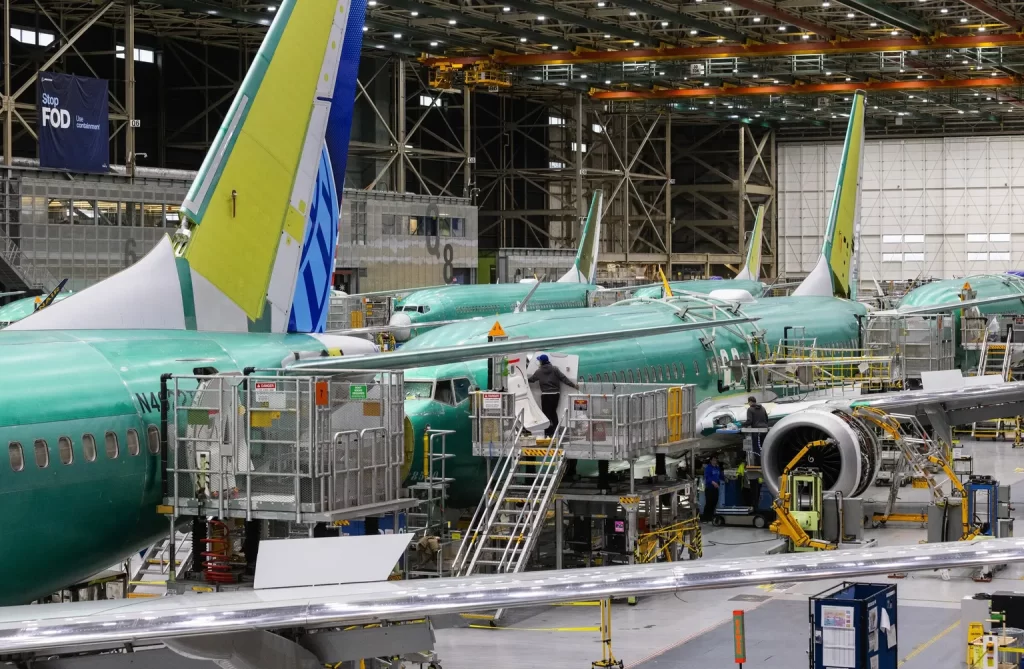By Jon Talton
Three things struck me as hair-on-fire points in my colleague Dominic Gates’ superb examination of Boeing’s prospects to right itself after four challenging years.
First, the company’s net debt has increased to nearly eight times from where it stood at the end of 2018. That’s nearly $40 billion. Half of this comes from the grounding of the 737 MAX after two fatal crashes, on top of development costs. And 20 years after the 787 Dreamliner was launched, Boeing still hasn’t made up for the investment in the long-delayed airliner.
Second, deteriorating relations between the United States and China have shut Boeing out of what was its largest export destination.
Boeing expected a long and prosperous relationship, going so far as to build a 737 completion and delivery center in China in 2015. Advantage for now to Airbus, which won orders from Beijing for 140 airliners late last year.
Timing is everything, or so it’s said, but Airbus can’t expect that edge for long. China’s state-owned airline manufacturer, COMAC, delivered its first passenger jet to China Eastern Airlines in December. President Xi Jinping has made a priority of developing Chinese-made advanced industries to wean itself off dependence on the West.
As a result, Boeing’s lethal stumbles with the MAX crashes and U.S.-China tensions risk shutting the company out of the market for good.
Third on my list was Airbus’ worldwide dominance, gained while Boeing was struggling for altitude. This past year, Airbus delivered 661 commercial airplanes compared with 480 for Boeing. Meanwhile, Airbus’ backlog of unfilled orders is 7,000 airliners, compared with about 4,500 for Boeing.
If I were seeing these challenges about any ordinary company, I’d say the firm was in trouble and might not be correctable.
But Boeing is no ordinary company.
In addition to its locally headquartered commercial airliners division, Boeing is one of the nation’s largest defense contractors. Its Defense, Space and Security unit is behind such products as the B-1B and B-52 bombers, the F-15 and FA-18 fighters, transports, and tankers, as well as helicopters and drones.
In space, Boeing has a hand in numerous rockets and spacecraft, including NASA’s Artemis program. It is intended to return humans to the moon for the first time since the last flight of Project Apollo in 1972.
Boeing is also one of America’s most important exporters, for both commercial airliners and arms.
If ever a company was “too big to fail,” a phrase usually associated with banks, it’s Boeing. And a good thing for Washington state, where Boeing has 60,000 employees and assemblies in Renton and Everett.
Yet Boeing’s self-inflicted wounds have been enormous, way beyond the 737 MAX, where the company’s delivery targets crucially depend on Federal Aviation Administration certification on the final two models along with the giant 777X.
Moving the headquarters from Seattle to Chicago, then to Arlington, Va., took it far from its engineering culture here to the bean-counter culture of McDonnell Douglas, in an effort to be near the nation’s political and regulatory center.
The jury’s still out on the effectiveness of that last move. At the time, aviation analyst Richard Aboulafia said if Boeing returned its headquarters to Seattle, it would have sent “an incredibly powerful message” about fixing Commercial Airplanes, its most important unit. But that’s not how the C-Suite thought.
Boeing’s chief executives were cut from the mold of General Electric CEO Jack Welch, who slaughtered employment in the effort to keep the stock price up. James McNerney came out of GE and lost out of the contest to succeed Welch. Even current CEO Dave Calhoun is a GE alumnus.
(History has not treated Welch well. His foray into financial services, GE Capital, was a disaster, nearly sinking the company during the Great Recession. New York Times reporter David Gelles wrote a book titled “The Man Who Broke Capitalism: How Jack Welch Gutted the Heartland and Crushed the Soul of Corporate America — and How to Undo His Legacy.”)
McNerney established a plant in North Charleston, S.C., attempting to bust Puget Sound unions — who were responsible for saving the much-delayed airliner. Later all Dreamliners assembly shifted there, where there have been ongoing production flaws.
This past month, The Wall Street Journal reported that Boeing employees were working on the delayed new Air Force One without security credentials. This isn’t the first stumble on this project. Former CEO Dennis Muilenburg underbid the contract to ensure President Donald Trump would select Boeing (as if Airbus would build the plane to carry POTUS). The result: A loss of nearly half a billion dollars. Calhoun said the “unique negotiation” resulted in “a very unique set of risks that Boeing probably shouldn’t have taken.”
Speaking of delays, delivery of the KC-46 tanker for the Air Force has been repeatedly set back, most recently because of a supplier error. The 767 freighter has also suffered delays.
Too big to fail means the smallest of consequences for a company. It means big costs for the taxpayers, although a federal bailout of Boeing seems unnecessary, at least for now.
If we could get in a time machine and return to the later decades of the 20th century, a different outcome was possible.
The United States had two major manufacturers of jet airliners besides Boeing. Douglas Aircraft produced a long line of passenger planes, including the widebody DC-10. After Douglas merged with McDonnell Aircraft, the premier jet was the narrowbody MD-80.
On the defense side, the B-1 bomber was made by North American Rockwell. General Dynamics produced a host of military aircraft, including the F-111. The iconic F-14 Tomcat naval air superiority fighter of the movie “Top Gun” fame came from Grumman.
But the merger mania of the 1980s and demands of Wall Street onward steadily reduced the number of companies, and with that, competition and innovation. Many were folded into today’s Boeing.
Is it better for being bigger? The evidence points against it.
Jon Talton: jtalton@seattletimes.com; on Twitter: @jontalton. Talton writes about business and the Pacific Northwest economy in the Sunday Seattle Times.

